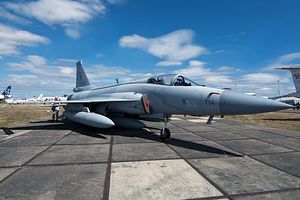Pakistan will not replace the JF-17’s Russian-made Klimov/Sarkisov RD-93 power plant with a new Chinese engine in the foreseeable future despite Chinese reports to the contrary, IHS Jane’s Defense Weekly reveals.
“We are completely satisfied with this Russian-made engine,” a representative of Pakistan Aeronautical Complex recently told IHS Jane’s Defense Weekly. The JF-17 Thunder combat aircraft was jointly developed by the Pakistan Aeronautical Complex and Chengdu Aircraft Industry Corporation (PAC/CAC).
PAC even plans to establish a full-scale servicing and overhaul facility for the Klimov/Sarkisov RD-93 engine in Kamra, also known as Aviation City, and the center of aircraft manufacturing in Pakistan.
“What does this tell you?” asked a PAC program officer rhetorically referring to the plans for an overhaul facility , according to IHS Jane’s Defense Weekly. “If the situation was as it has been portrayed at times – that we are just utilizing the RD-93 as a temporary solution until the Chinese can ‘save’ us with their own new engine – then we would not be expending the resources to set up this overhaul base. For us, changing to another engine would not make any sense and would be disruptive and cause a huge expense for the JF-17 program.”
Money, however, is not the sole reason why Pakistan is adamant about sticking with the RD-93 engine. China’s aircraft industry has had difficulties in designing and building a powerful enough and reliable indigenous jet engine for some time.
Even the People’s Liberation Army Air Force’s fifth-generation fighter prototypes, the Chengdu J-20 and Shenyang J-31, both are flying with older Russian-made jet engines, the J-20 with the Saturn AL-31 and the J-31 with the Klimov RD-93.
One reason for Beijing’s recent purchase of 24 Russian-made Sukhoi Su-35 multirole fighter jets is the Russian aircraft’s powerful AL-117S turbofan engines, which China can now reverse engineer. The most advanced Chinese-made military turbofan currently in use is the WS-10, which, however, continues to underperform.
Consequently, there is little reason to believe that Pakistan will procure Chinese-made engines for the JF-17 in the foreseeable future.
“When we designed the JF-17 we evaluated a number of design alternatives and we determined that the RD-93 in this single-engine installation is absolutely right for this application,” another PAC representative said. “We worked extensively with the people from Klimov bureau in St Petersburg [Russia] and this engine turned out to be an ideal solution.”
In December 2014, Russia and Pakistan also announced a defense cooperation agreement, which stipulated that Islamabad would buy the the Klimov RD-93 engine directly from Moscow, instead of acquiring the hardware vicariously via China.
As I reported earlier in November (See: “Groundhog Day: China-Pakistan JF-17 Fighter Has its First Buyer”), according to Chinese media reports, an export deal for the JF-17 was signed during the Dubai Air Show this month with an unidentified Asian country. However, PAC representatives interviewed by IHS Jane’s Defense Weekly during the Dubai Air Show did not seem aware that a contract had been signed.
“The experience at [the Paris Airshow in] Le Bourget brought about 11-12 countries that approached us with some interest in a JF-17 acquisition,” said one of the PAC officials. “Out of all of those there are today some four or five customers that we regard as being serious prospects in the near term.”































